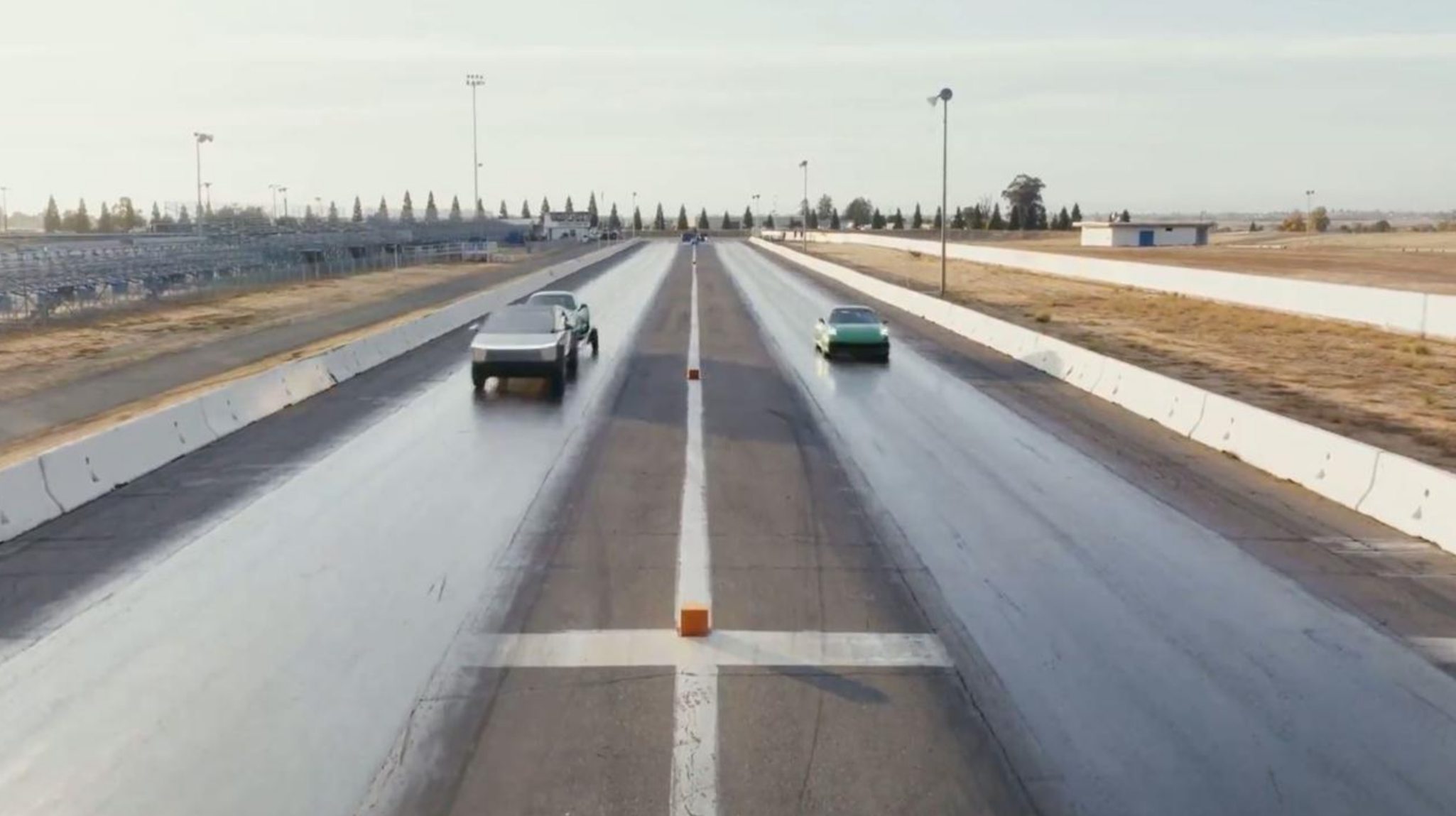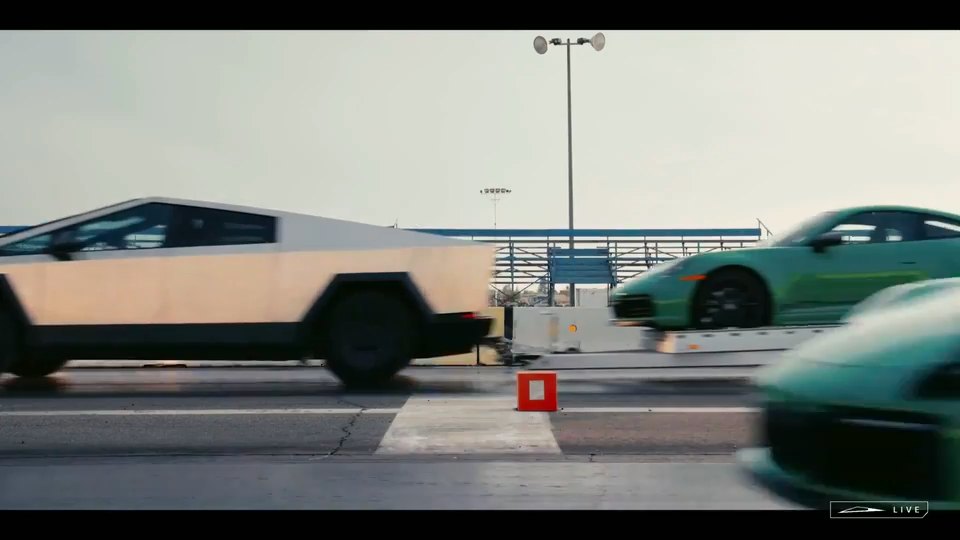Tesla Cybertruck beats 911 in drag race while TOWING A 911

14,000Nm and 845hp will do that to a car. Click the image below to watch the video.

The recent video of a Tesla Cybertruck EV outperforming a Porsche 911 in a 400-meter drag race while towing another 911 has generated excitement and debate. This is an in-depth analysis of the Cybertruck's remarkable performance. Read more EV News.
Overview
While the video clearly demonstrates the Cybertruck's straight-line speed capabilities, there are some important caveats. Details like the specific 911 models used and the exact length of the race are uncertain. Additionally, the video was produced by Tesla themselves under controlled conditions to highlight the truck's acceleration. Fully evaluating its real-world performance will require extensive independent testing under varied scenarios. With those qualifiers stated, the video does reveal the immense torque and off-the-line punch enabled by the Cybertruck's electric powertrain.
The Cyberbeast
The top-of-the-range Tesla Cybertruck trim, known as the "Cyberbeast", boasts truly remarkable specifications that optimise it for incredible straight-line acceleration. This avant-garde electric truck uses a powertrain with three separate motors, producing a staggering 630 kilowatts (845 horsepower). In comparison, the latest Porsche 911 Turbo S sports car only manages 477 kilowatts (640 horsepower). The immense power output of the tri-motor Cybertruck enables it to accelerate from 0-97 km/h in a supercar-rivalling 2.9 seconds, according to Tesla's estimates. This makes the Cybertruck one of the quickest accelerating production pickup trucks ever conceived.
In addition to its rapid acceleration, Tesla claims the Cybertruck also boasts a top speed of 209 km/h. While not as high as some sports cars, achieving 209 km/h in a full-size truck is quite an impressive feat. The Cybertruck achieves this thanks to the immense torque output from its electric motors. The instant and abundant torque is another advantage the Cybertruck has over petrol-powered trucks reliant on combustion engines. Tesla estimates the Cyberbeast produces over 13,558 Nm (10,000 pound-feet) of torque, allowing it to tow up to 4,990 kilograms (11,000 pounds).
Make no mistake, while the Cybertruck delivers supercar-rivalling straight-line performance, it remains a highly capable pickup truck. Despite a towing capacity slightly below the original 6,350 kilograms (14,000 pound) claim, 4,990 kilograms (11,000 pounds) is still sufficient for most owners’ needs. Towing over 4,536 kilograms (10,000 pounds) up steep gradients or at motorway speeds requires serious muscle, which the Cyberbeast provides in abundance. The Cybertruck’s towing capabilities compare well against upcoming rivals like the Rivian R1T electric truck.
Enhancing the towing capacity is a generous payload rating of up to 1,134 kilograms (2,500 pounds) for hauling cargo in the bed. While also lower than original targets, it compares favourably to conventional trucks. Payload is an important metric for truck owners requiring real utility. Between robust towing and payload ratings, the Cybertruck should satisfy most truck buyers’ work needs despite its exotic acceleration.
- Top-of-the-range Tesla Cybertruck "Cyberbeast": Offers remarkable specifications for straight-line acceleration.
- Powertrain with Three Motors: Produces 630 kW (845 horsepower).
- Acceleration: Achieves 0-97 km/h in 2.9 seconds, among the quickest for production pickup trucks.
- Top Speed: Boasts a top speed of 209 km/h.
- Torque Output: Immense torque of over 13,558 Nm (10,000 pound-feet) from electric motors.
- Towing Capacity: Can tow up to 4,990 kilograms (11,000 pounds).
- Comparison to Petrol-Powered Trucks: Superior instant torque over petrol-powered trucks.
- Payload Rating: Offers a payload capacity of up to 1,134 kilograms (2,500 pounds).
- Utility: Maintains practical truck capabilities despite high performance.
- Target Buyers: Appeals to those balancing between high-speed performance and practical utility.
- Market Positioning: Competes with electric trucks like Rivian R1T, offering both performance and utility.
Porsche 911 Overview
The Tesla Cybertruck's victory over a Porsche 911 in a drag race, even while towing another 911, showcased the iconic German sports car in a subsidiary role. However, the various 911 models themselves have a notable history and distinct specifications that are noteworthy.
Porsche's flagship model for decades, the rear-engined 911, comes in a myriad of versions to suit various budgets and performance desires. The standard 911 Carrera, the entry-level model, features a 283 kW (379 horsepower) twin-turbo 3.0L flat-six engine, enabling a 0-97 km/h acceleration in just 4.2 seconds. The 330 kW (443 hp) Carrera S reduces this sprint to 3.5 seconds.
The Carrera and Carrera S models utilise extensive aluminium and other lightweight materials, with curb weights ranging from approximately 1,451 to 1,633 kg depending on body style and options. Their compact size and rear weight bias offer exceptional agility and traction. The availability of all-wheel drive further enhances grip.
Although the specific 911 variants used in the Cybertruck video weren’t specified, the Carrera and Carrera S are the most commonly seen. More extreme and costly options like the track-focused GT3 or the turbocharged Turbo S would be unlikely choices for such promotional activities due to their high costs. The Carrera S likely provided the optimal balance of performance and affordability.
With its immense torque immediately available, the Cybertruck was too powerful for even Porsche’s renowned sports car. However, whether competing against a pickup or setting lap records, the 911’s combination of power, agile handling, and daily drivability has established it as a standard in sports cars for over 50 years. Although the Cybertruck won this particular contest, the 911's capabilities and heritage ensure it remains one of the world's leading driver's cars for the foreseeable future.
Analysis
Although Tesla's video clearly showcases the Cybertruck's potent straight-line acceleration, defeating a Porsche 911 while towing another is a remarkable display. Nonetheless, the specifics of the race and the 911 variants involved are uncertain, which limits definitive conclusions. Independent testing in various real-world conditions is necessary to fully verify the Cybertruck's capabilities.
The Cyberbeast's 630 kW (845 hp) and immediate torque from its electric motors provide it with a traction advantage for rapid acceleration. However, its 2.9 second 0-97 km/h time is an estimate, and its approximate 3,175 kg curb weight while towing may affect its longer distance speed. The exact model of the 911 is also unclear, though the base Carreras weigh just about 1,497 kg with 283 kW (379 hp). Therefore, while the video serves as a powerful marketing tool, questions about real-world range, handling, and consistent performance remain unanswered. Tesla's previous unmet claims suggest that even its estimates may not always be accurate. Thus, a thorough evaluation of the Cybertruck will necessitate extensive testing across a range of scenarios, not just in idealised conditions designed for public relations victories.
Comments
No posts found










